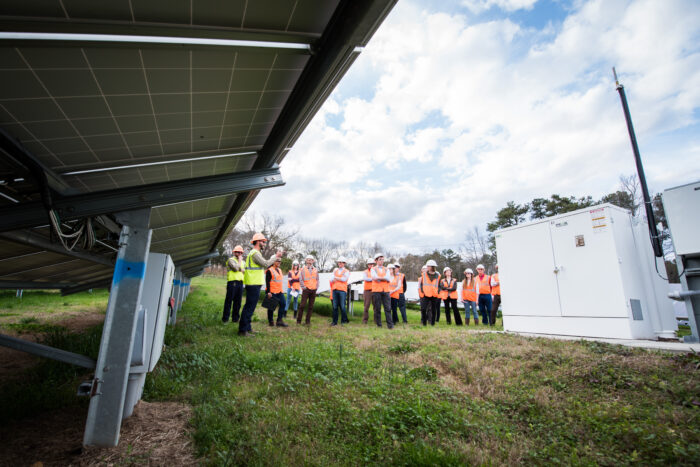Historic federal climate action: What it means for the South
Updated August 16, 2023
We are at a critical moment to address the causes and consequences of climate change and the stakes for our environmental future have never been higher but the opportunities have never been greater.
One year ago, Congress passed the most comprehensive and ambitious climate legislation our country has ever seen, setting into in motion a paradigm shift that will help our region and nation mitigate and adapt to climate change at an unprecedented pace.
This federal climate action, known as the Inflation Reduction Act or IRA, provides a generational opportunity to address the climate crisis, and at SELC, we are seizing this moment with urgency and optimism.
The impacts of climate change are upon us, but at SELC, we know the path forward to take advantage of a once-in-a-lifetime opportunity to address the climate crisis.
Alys Campaigne, SELC Climate Initiative Leader
What is the Inflation Reduction Act or IRA?
From fighting harmful pollution to catalyzing clean energy programs, this historic legislation now signed into law will create hundreds of thousands of new jobs, cut energy costs, and play a critical role in the fight against climate change. Since its passage one year ago, the Inflation Reduction Act has already led to the announcement of 272 new clean energy projects nationwide, resulting in over 170,000 new jobs and generating over $278 billion in new investments for local communities.
There has not been a landmark investment of this magnitude since FDR’s New Deal in the 1930s. If spent wisely, we can use the $369 billion in climate and clean energy funding to reduce U.S. carbon emissions by 40 percent by 2030. We can also use these dollars to rectify longtime environmental injustices for communities of color and people earning a lower wage and ensure their voices are heard and valued in considering these new opportunities.
But without oversight and partnerships at the state and local level—where decisions with decades’ long consequences will be made—taxpayer money could be squandered on damaging projects that worsen rather than solve problems from climate-fueled storms, flooding, heat, and drought, and put more people in harm’s way.
What type of projects are funded by IRA?
The Inflation Reduction Act’s projects, incentives, and funding will allow us to bend down the arc of climate change and reshape our future. Here are a few examples of how IRA is being implemented on the ground, with more to come.

- $16 billion to combat greenhouse gases and cut carbon pollution
- $7 billion to connect and restore our coasts, wetlands, and forests
- $3 billion to an environmental justice grant program giving community-based organizations resources to address pollution locally
- Tax credits for new and used electric vehicles
- Clean energy tax credits making it cheaper to deploy wind and solar power
- Funding to develop plans to deal with the impacts of a changing climate and build more resilient communities
IRA programs working in tandem with other federal legislation, like programs from the 2021 Infrastructure Investment and Jobs Act – which authorized $1.2 trillion in transportation and infrastructure investments – help our communities decarbonize and become more resilient.
How does IRA address a legacy of environmental injustice?
Ensuring the climate plan is implemented effectively is especially critical in the South. Like many areas around the country, our region has historically placed environmental burdens of industrial pollution on Black, Indigenous, Latino, and other communities of color.
Not only do these communities continue to face environmental injustices, but are also on the front lines of feeling the impacts of a changing climate. Implemented correctly, IRA will ensure that communities of color and areas where residents earn a lower or fixed income are not left behind, and that longtime environmental injustices are addressed.
How can IRA contribute to a more equitable South?

IRA has the power to alleviate the disproportionately high energy burden many Southern families experience while transitioning us away from fossil fuels. The legislation provides funding opportunities for rooftop and community solar and energy efficiency programs, opening access to cleaner, more cost-effective energy, lowering usage and providing savings on monthly bills. It helps communities protect against extreme heat and flood risk.
IRA can also create tens of thousands of local clean energy jobs in the South. In places like Coweta County, Georgia, and Florence County, South Carolina, we’re already seeing a rise in solar manufacturing jobs due to IRA funding.
What is SELC’s role for IRA implementation?
The Inflation Reduction Act is federal legislation, but funding decisions are being made at the state and local level, right now or in the near future. So many details surround choices that will be made, and our collective environmental future will turn on these details — details SELC understands.
We need to make sure the legislation’s tax breaks and subsidies are used to fulfill their climate and equity promises here in the South to continue to move our region away from fossil fuels to a cleaner energy future. We also must remain vigilant against any efforts to direct funding toward harmful infrastructure projects that do more damage to our environment and impact already overburdened communities.
We have the opportunity of a lifetime to leverage vital political leadership and momentum to create solutions to address the causes and consequences of a changing climate. It is a moment we cannot take for granted.
